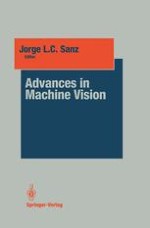1989 | OriginalPaper | Chapter
Control-Free Low-Level Image Segmentation: Theory, Architecture, and Experimentation
Authors : W. E. Blanz, J. L. C. Sanz, D. Petkovic
Published in: Advances in Machine Vision
Publisher: Springer New York
Included in: Professional Book Archive
Activate our intelligent search to find suitable subject content or patents.
Select sections of text to find matching patents with Artificial Intelligence. powered by
Select sections of text to find additional relevant content using AI-assisted search. powered by
In this chapter, the computer vision problem of segmenting images is addressed. Our approach is based upon the fact that low-level image segmentation is a model-driven operation, conveyed in a way that all relevant knowledge gathered in a supervised learning phase is used in parallel in the segmentation process. Such a control-free image segmentation can be achieved by using a pattern-recognition approach. This method uses a relatively large number of local image features and combines them optimally according to the scene knowledge acquired in a training phase by the use of a supervised classification procedure. In this methodology, training is performed by the user, outlining the image regions belonging to each class. There are two major advantages accrued from this approach. First, the need for expert image-analysis knowledge is minimized, since the user selects what is to be segmented and is not required to determine how this segmentation is to be accomplished. Second, this approach is amenable to parallel pipeline hardware implementation. Extensive experimentation with many different industrial problems demonstrates that this approach is an effective and useful building block for low-level computer vision applications.
